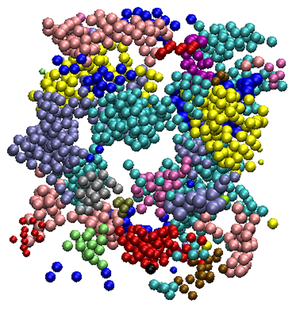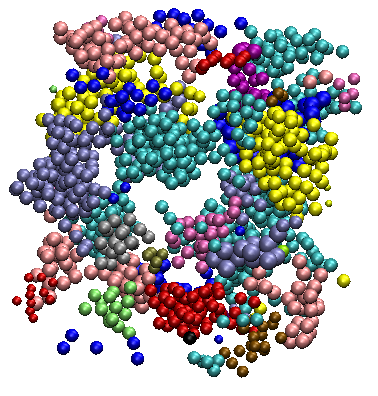Particle Clustering Phenomena Inspire Multiple Explanations
Particles that move of their own accord, such as bacteria or beads propelled by chemical reactions, can organize themselves into diverse arrangements, such as clusters of a fixed size or clusters that keep growing. The reasons for these behaviors are discussed by researchers presenting computer simulations in Physical Review Letters and Physical Review E. These phenomena depend on the balance of opposing forces, according to one of the reports. By adjusting those forces in artificial systems, it might become possible to design materials that assemble and repair themselves from their microscopic components.
Self-propelled, or “active,” particles are common in the living world, ranging from packages carried along protein strands by molecular motors in living cells to the spectacularly organized flocks of birds and schools of fish. Researchers have found ways to make such particles artificially at microscopic scales, for example, by attaching motor proteins to the surfaces of synthetic particles, or by using chemistry to drive nanoparticles through a solution. Understanding the collective behavior of these active particles might help to explain how cells form exquisitely organized structures, such as the starlike clusters of filaments involved in cell division, and could suggest new ways to enable matter to organize itself at tiny scales into useful structures.
In some previous studies, the particles formed clusters that grew until they reached a particular size [1,2]. These clusters are called “living” because particles continually join and leave, while the average cluster size remains fixed. In contrast, for colloidal particles that lack activity, aggregation, once triggered, generally proceeds without limit, as when particles settle out of river water as sediment.
Other experimental and theoretical studies have found that active colloids may aggregate into a single dense cluster that grows continuously [3]. On the other hand, experiments on bacteria whose interactions were “tuned” with additives to the solution have shown that the activity of these “particles” can actually suppress this aggregation [4].
Some previous studies have explained the formation of living clusters as due either to the attractive forces between the particles or to self-propulsion essentially pushing particles together. But might there be some deeper, general mechanism beneath these seemingly different explanations? To find out, Chantal Valeriani of the Complutense University of Madrid and her colleagues used computer simulations to observe two very different sorts of active particles.
In one system, mimicking chemically propelled metal particles [1], there was an attractive force between particles, while their self-propulsion disrupted their tendency to aggregate. In the other system, there was no interaction between the particles, except when they bounced off one another (a type of repulsion). But the self-propulsion was of a sort that pushed particles toward one another once they came within a certain distance. This second system mimicked an experiment in which inorganic particles with motor proteins attached were pulled together along protein filaments, itself mimicking organizational processes inside living cells [5].
Despite the nearly opposite setups, both systems formed living clusters, provided that the concentration of particles was not too large. The researchers say that the essential ingredient is a balance between interparticle forces (attraction or repulsion) and self-propulsion. Living clusters appear “whenever there are these competing tendencies, as long as they are of comparable magnitude,” says Valeriani. She says that the ratio of the two influences determines the average size of the clusters. Crudely speaking, the ratio sets the point at which one influence removes new particles from a cluster as fast as the other adds them, although the precise mechanism remains to be clarified.
Another set of simulations was reported in Physical Review E in July, by Michael Hagan of Brandeis University in Waltham, Massachusetts, and colleagues. They exhaustively mapped out the behaviors of active particles moving in a two-dimensional plane as they varied the strength of interparticle attractions and the strength (velocity) of propulsion. The team found that a single, dense cluster can form at both low and high propulsion strengths, but not at intermediate strengths (unless attraction is very large). In the low-propulsion case the aggregation is driven by the attractive forces and in the high-propulsion case by particles getting pushed together.
It’s not yet clear if these two studies are consistent, partly because they consider different particle densities. Hagan and his colleagues also saw small clusters in the mid-range of propulsion strengths, but they interpret these clusters as the expected density fluctuations that occur as any system approaches a phase transition. (The formation of the large, dense cluster is a phase transition, like a solid or liquid condensing from a gas, whereas the living clusters are not technically a distinct phase.)
Michael Cates of Edinburgh University in the UK is skeptical that a balance between attraction and activity will always generate living clusters. He and his co-workers recently found what he says is a counter-example in theoretical calculations [6], although, like Hagan’s work, they involved higher density than Valeriani’s simulations. “The balance between equilibrium forces and activity can lead to finite clusters, but also might not,” says Cates.
One motivation for continued research is that active colloids could allow assembly of tiny particles into well defined structures “whose size can be tuned by changing the activity,” says Valeriani. What’s more, the clusters can move, for example, rotating as a group, as seen by Valeriani and her colleagues and in the earlier experiments on bacteria [4]. “Active matter promises the ability to build new kinds of materials with dynamic properties not possible in traditional materials,” says Hagan.
–Philip Ball
Philip Ball is a freelance science writer in London. His latest book is How Life Works (Picador, 2024).
References
- I. Theurkauff, C. Cottin-Bizonne, J. Palacci, C. Ybert, and L. Bocquet, “Dynamic Clustering in Active Colloidal Suspensions with Chemical Signaling,” Phys. Rev. Lett. 108, 268303 (2012)
- J. Palacci, S. Sacanna, A. P. Steinberg, D. J. Pine, and P. M. Chaikin, “Living Crystals of Light-Activated Colloidal Surfers,” Science 339, 936 (2013)
- G. S. Redner, M. F. Hagan, and A. Baskaran, “Structure and Dynamics of a Phase-Separating Active Colloidal Fluid,” Phys. Rev. Lett. 110, 055701 (2013)
- J. Schwarz-Linek, C. Valeriani, A. Cacciuto, M. E. Cates, D. Marenduzzo, A. N. Morozov, and W. C. K. Poon, “Phase Separation and Rotor Self-Assembly in Active Particle Suspensions,” Proc. Natl. Acad. Sci. 109, 4052 (2012)
- E. D. Spoerke, G. D. Bachand, J. Liu, D. Sasaki, and B. C. Bunker, “Directing the Polar Organization of Microtubules,” Langmuir 24, 7039 (2008)
- J. Stenhammar, A. Tiribocchi, R. J. Allen, D. Marenduzzo, and M. E. Cates, “Continuum Theory of Phase Separation Kinetics for Active Brownian Particles,” Phys. Rev. Lett. 111, 145702 (2013)





